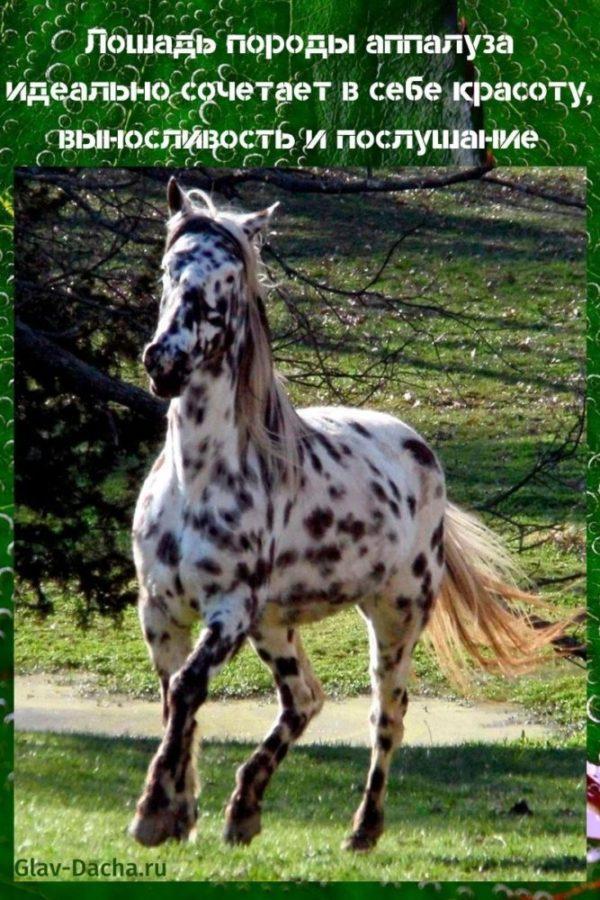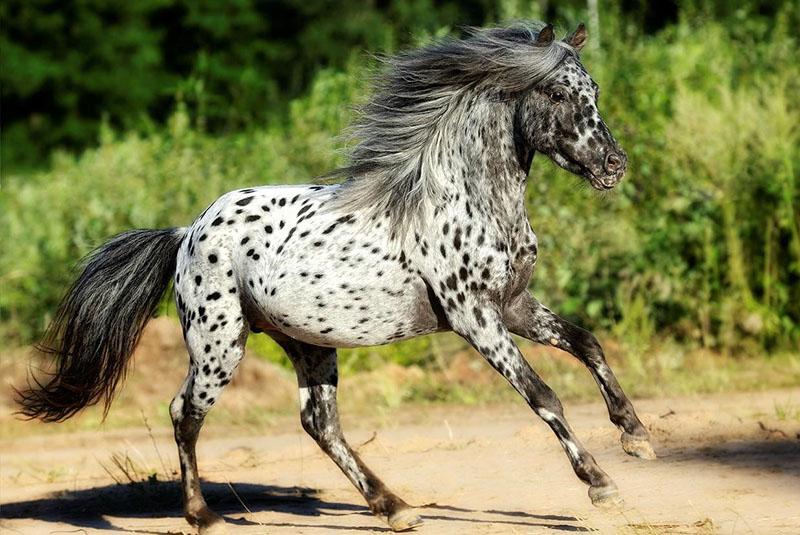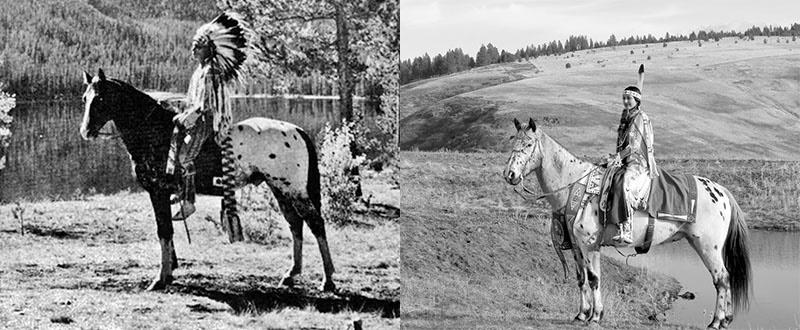The Appaloosa horse perfectly combines beauty, endurance and obedience
 The Appaloosa horse is suitable for exhibitions, competitions and riding. Amazing endurance and meek disposition, combined with an even figure and variegated color, makes these equids a kind of object of worship. Therefore, it is worth finding out some of the features of the forelock suit, as well as the subtleties of breeding representatives of this species.
The Appaloosa horse is suitable for exhibitions, competitions and riding. Amazing endurance and meek disposition, combined with an even figure and variegated color, makes these equids a kind of object of worship. Therefore, it is worth finding out some of the features of the forelock suit, as well as the subtleties of breeding representatives of this species.
A bit of history

 However, after the military conflict in 1877, when the Indian tribes suffered a great defeat and were forced to leave their native lands, the number of these horses was significantly reduced. Horse breeding has suffered heavy losses.
However, after the military conflict in 1877, when the Indian tribes suffered a great defeat and were forced to leave their native lands, the number of these horses was significantly reduced. Horse breeding has suffered heavy losses.
The original name of the horses comes from the Palouse River (eastern Washington and northern Idaho), on the banks of which a tribe of Indian horse breeders lived. Seeing the motley horses in the area, the white settlers called them Palous. However, in the absence of clear diction, it sounded like "Appaloosa".
 In 1938, a club of spotted breed lovers was formed, headed by Claude Thomson. The brave farmer and his team have resumed the population of the species. Thanks to the efforts of these enthusiasts, there are now about 500 thousand individuals in the world. Some of them have even become world-class winners.
In 1938, a club of spotted breed lovers was formed, headed by Claude Thomson. The brave farmer and his team have resumed the population of the species. Thanks to the efforts of these enthusiasts, there are now about 500 thousand individuals in the world. Some of them have even become world-class winners.
The Appaloosa horse in all its glory
 A characteristic feature of the species is an extraordinary suit, which has millions of color combinations and shades.
A characteristic feature of the species is an extraordinary suit, which has millions of color combinations and shades.
All this diversity is combined into 7 main categories:
- saddle cloth (pronounced saddle-shaped pattern on the back);
- roan (white hair dominates in wool);
- spotted (of various shapes);
- roan and spotted saddle cloth;
- a suited roan and with spots.
 Young animals are born with light coat. Over time, it takes on either a dark or light shade. Closer to the age of five, the final color of the stallion becomes more contrasting.
Young animals are born with light coat. Over time, it takes on either a dark or light shade. Closer to the age of five, the final color of the stallion becomes more contrasting.
In this regard, there are 5 leading types of suit:
- leopard (dark blotches on a white background);
- frost (light color with dark spots);
- snowflake (concentration of the pattern in the hips);
- black-backed (drawing in the back);
- marbled speckled (intense dark blotches).

The Appaloosa gaze is mesmerizing with its expressiveness. It is the unusually light sclera that makes the horses' eyes so distinct.
In addition to their spectacular color, spotted horses are valued for their proportional physique. The neat head with pointed ears is in perfect harmony with the sinewy and strong neck. Despite the low growth of 150-160 cm, the weight of the individual is 500-600 kg. The rounded, powerful torso with a short, muscular back is ideally complemented by a silky mane and a high-set, bushy tail.
A distinctive feature of the variety is a white speck on the face. In addition, hard, massive hooves always have vertical white or black stripes.
"Angelic character"
 Calmness and complaisance is what the Appaloosa horse is so prized for. Animals are very attached to their owners, quickly find a common language with them and remain faithful throughout their lives.The change of rider is very stressful, which leads to the manifestation of a violent disposition. Despite the presence of gentleness and good nature in character, horses of this species are distinguished by extraordinary fearlessness and courage.
Calmness and complaisance is what the Appaloosa horse is so prized for. Animals are very attached to their owners, quickly find a common language with them and remain faithful throughout their lives.The change of rider is very stressful, which leads to the manifestation of a violent disposition. Despite the presence of gentleness and good nature in character, horses of this species are distinguished by extraordinary fearlessness and courage.
Artiodactyls quickly adapt to conditions and teaching methods thanks to:
- high activity;
- incomparable intelligence;
- sociability.
Pupils in a short time memorize all the complexes of teams and tricks necessary to participate in the competition. They also easily make contact with other animals. The Appaloosa horse is often chosen for riding, especially for debut riders. A well-trained horse is able to drastically change the manner and speed of the race, while avoiding rigid movements and maintaining evenness of breathing.
The variety has a thin-boned constitution. Still, this does not prevent her from remaining hardy and covering distances of thousands of kilometers in the absence of her usual food bases.
Features of nutrition and care
 Feed quality and a well-chosen diet are key factors in keeping an Appaloosa horse.
Feed quality and a well-chosen diet are key factors in keeping an Appaloosa horse.
The menu of luxury horses must be present (for an individual of 500-600 kg):
- hay (13 kg / day or 2 tons / year);
- wheat or rye bran (1.5 kg / day or 1.6 t / year);
- juicy feed (3 kg / day or 1.2 t / year).
Water tanks are installed in the stables, which are constantly changing. Due to this, the liquid does not stagnate and does not overcooled.
 It is recommended to feed the horse at the same time. Compliance with this regime helps to improve the digestion process and complete assimilation of feed. Otherwise, it will lead to a stressful state. In addition, the nutritional order of the Appaloosa is taken into account. Hay is preferred in winter (½ of the daily value) and in summer fresh grass is preferred.
It is recommended to feed the horse at the same time. Compliance with this regime helps to improve the digestion process and complete assimilation of feed. Otherwise, it will lead to a stressful state. In addition, the nutritional order of the Appaloosa is taken into account. Hay is preferred in winter (½ of the daily value) and in summer fresh grass is preferred. Some horse breeders mix hay with corn, oat, or millet straw.
Some horse breeders mix hay with corn, oat, or millet straw.
Also, the livestock needs:
- chopped legumes (vetch, peas or chickpeas) up to 2 kg / day;
- oats (fresh, steamed or milled);
- fresh / boiled root vegetables and vegetables (potatoes, carrots, fodder beet);

- boiled grains of wheat or barley mixed with cake / peas).
In the summer months, luscious greens are the main diet. However, after winter, it is introduced very carefully, in small portions. Combined feeds are also added to the main menu.
For the summer keeping of the Appaloosa horses, open camps are quietly prepared, and for the winter - stables. Such facilities are constantly cleaned.
 The mane and tail need constant care. With the help of brushes, the fur of the horses is carefully combed out. The horseshoe is carried out only by specialists who accurately select the size of the horseshoe, and then install it correctly. Swimming is performed exclusively in the warm season. After the races, the animal is covered with a blanket. When the horse cools down, it is prepared for water procedures. As you can see, without love and attention it is impossible to breed Appaloosa horses.
The mane and tail need constant care. With the help of brushes, the fur of the horses is carefully combed out. The horseshoe is carried out only by specialists who accurately select the size of the horseshoe, and then install it correctly. Swimming is performed exclusively in the warm season. After the races, the animal is covered with a blanket. When the horse cools down, it is prepared for water procedures. As you can see, without love and attention it is impossible to breed Appaloosa horses.
Unusual horses of the Appaloosa breed - video
https://www.youtube.com/watch?v=MlPtR4DqqKM